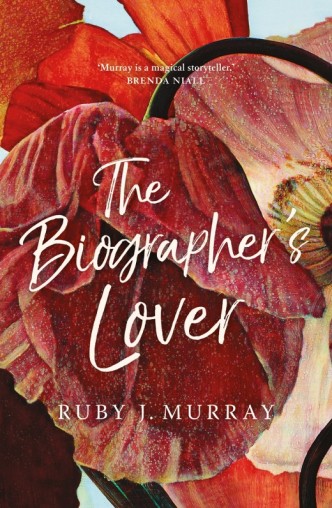Tags

Novels about biographers form a rich subgenre of twentieth and twenty-first century fiction. Henry James’ Aspern Papers (1888) is one of the earliest; A.S. Byatt’s Possession (1990) is another landmark. I wrote about the subgenre for my creative writing dissertation to accompany my own unpublished attempt, “The Remains” (earlier title “Immortalities”). It was this project that made me decide I wanted to be a biographer myself. Usually, biographer novels take on the form of a quest – the quest for truth of the subject’s life, often involving the recovery of lost letters or diaries. Australia has its own examples of the genre, including Louis Nowra’s Ice (2008 – Lisa’s review and mine) and Virginia Duigan’s The Biographer (2008). In her second novel, The Biographer’s Lover (Black Inc, 2018), Ruby Murray has created a compelling Australian biographical quest narrative that works within many of the conventions of the subgenre while adding its own rich elements.
The Biographer’s Lover is narrated by an unnamed (I think) woman of twenty-nine, commissioned by a family to ghost-write a biography of their mother, a recently dead painter named Edna Cranmer. Edna’s daughter hopes for Edna to achieve posthumous fame for her largely unexhibited work, including war paintings; the rest of her family are far more wary about the project. Inevitably, the biographer soon realises there are old secrets in the family and must not only unravel the mysteries of Edna’s life but decide what to do with the hard-won knowledge. Like many biographical quests, the novel also features echoes between the biographer’s life and the subject’s; a climactic (literal) journey of discovery; and a secret about paternity. (Biographical quests keep coming back to this last one – I unwittingly did; Possession does, Virginia Smith’s Carradine Diaries does, John Harwood’s The Ghost Writer does; Duigan’s The Biographer does, to name the examples which come to me first.)
Many biographical quests reproduce letters or diaries to reveal the past. The Biographer’s Lover doesn’t, relying on the biographer’s interviews with people who knew Edna and, particularly, on what is revealed by paintings and sketchbooks. Early on, we read Edna’s letters are embargoed until well into the future; I wondered if it was an addition to the text suggested by an editor to explain the lack of them. Regardless, the lack of letters allows Murray to focus on the art, which is a wise choice. The scope needs to be limited in a novel like this.
Like my own novel, the past strand of the subject’s life is narrated through excerpts from the biography the biographer is writing. In my study of the genre, I found this to be a less common approach – usually the past is narrated through documents and sometimes by direct narration. I agonised over the tone and style of my biography excerpts. Can a fictional biography – in the style of conventional biography – hold the reader? Probably not in large doses; knowing it’s a fiction means the reader has less patience. These sections of the novel felt flatter than the rest; wisely, Murray keeps them short. One of their strengths is the excellent interweaving of actual historical incident, including World War Two and the Ern Malley hoax.
For me, an unexpected pleasure of The Biographer’s Lover was the evocation of Geelong. It’s a novel as much about the Victorian city as writing biographies, saturated in the culture of the place, its sights and sounds and smells, its football and factories and relationship to Melbourne. I’ve never been to Geelong but now I feel I know something of it, and it reminds me in some ways of my quasi-hometown of Bunbury.
Like many examples of the genre, The Biographer’s Lover has a complex plot, with many twists and turns. It could have comfortably been much longer and developed its characters further, but I appreciated its brevity. This is an accomplished novel, a gripping story of family secrets, a character study of class, and a landscape of Geelong.

Nathan, I was about to message you and ask whether you had seen Suzanne Falkiner’s review of The Biographer’s Lover in this month’s Australian Book Review? She makes similar points to yours, and mentions the black swan motif from the Ern Malley hoax.
LikeLike
Oh, I must check out her review. Thanks Ted.
LikeLike
I can scan and send if you like
LikeLiked by 1 person
I’ll be reading this soon so I haven’t read this review, just bookmarked it for when I do.
LikeLike
I’ll be interested in your thoughts!
LikeLike
Soon, I promise, soon. I really liked her first novel…
PS Congratulations on your new daughter!
LikeLike
Thanks Lisa! Hope to post a photo soon.
LikeLike
I enjoyed your review of this Nathan. I’m not sure I’ll get to read it, but I may be hosting a guest post on it in coming weeks. Novels about biographers get me in too, not that I’ve read a lot, but Possession bowled me over when I read it.
LikeLiked by 1 person
Thanks Sue – look forward to your guest post, if it comes.
LikeLiked by 1 person
I hope it comes 🤞
LikeLike
Interesting that it was a novel about biographers that got you started. On that basis it’s lucky I didn’t end up in the French Foreign Legion (not sure I’ve ever read a novel about truckies).
LikeLike
Pingback: ANZ LitLovers LitBlog
Here’s my review, Nathan: https://anzlitlovers.com/2018/12/15/the-biographers-lover-by-ruby-j-murray/
What a brilliant book!
LikeLike
Pingback: New Oz Lit Fic | theaustralianlegend
Pingback: Six Degrees of Separation: from True History of the Kelly Gang, to…. | ANZ LitLovers LitBlog